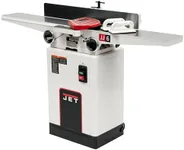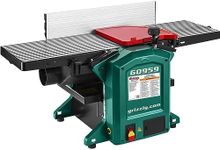Buying Guide for the Best Planer and Jointer Combos
When it comes to woodworking, a planer and jointer combo can be an invaluable tool. These machines combine the functions of both a planer and a jointer, allowing you to flatten, square, and dimension your wood pieces with precision and efficiency. Choosing the right planer and jointer combo involves understanding several key specifications that will impact the performance and suitability of the machine for your specific needs. Here’s a guide to help you navigate through the important specs and make an informed decision.Cutting WidthThe cutting width refers to the maximum width of the wood that the machine can handle. This is important because it determines the size of the wood pieces you can work with. Cutting widths typically range from 6 inches to 12 inches or more. If you primarily work with smaller pieces of wood, a 6-inch model may suffice. However, for larger projects or if you want more versatility, consider a model with a wider cutting width.
Cutting DepthCutting depth indicates how much material the machine can remove in a single pass. This is crucial for efficiency and achieving the desired thickness quickly. Cutting depths can vary, but a range of 1/8 inch to 1/4 inch per pass is common. For heavy-duty work, a deeper cutting depth can save time, but for finer, more precise work, a shallower depth may be preferable.
Motor PowerMotor power, measured in horsepower (HP), affects the machine's ability to handle tough materials and maintain consistent performance. Motors typically range from 1 HP to 3 HP or more. For light to moderate use, a 1-2 HP motor may be sufficient. For more demanding tasks or frequent use, a more powerful motor will ensure smoother operation and longer machine life.
Cutterhead TypeThe cutterhead is the part of the machine that holds the blades and does the actual cutting. There are two main types: straight knife and helical (spiral) cutterheads. Straight knife cutterheads are generally less expensive and easier to maintain, but helical cutterheads provide a smoother finish and are quieter. If you prioritize finish quality and noise reduction, a helical cutterhead is a better choice.
Table LengthThe table length affects the stability and support of the wood during operation. Longer tables provide better support for longer pieces of wood, reducing the risk of snipe (unwanted cuts at the beginning or end of a board). If you work with long boards frequently, look for a machine with a longer table. For smaller projects, a shorter table may be adequate.
Dust CollectionDust collection is an important feature for maintaining a clean and safe workspace. Planer and jointer combos can produce a significant amount of wood shavings and dust. Look for models with effective dust collection ports that can be connected to a shop vacuum or dust collection system. This will help keep your work area clean and reduce health risks associated with wood dust.
Fence AdjustabilityThe fence on a jointer helps guide the wood and ensures straight, square edges. An adjustable fence allows you to set different angles and provides more versatility in your work. Look for a sturdy, easily adjustable fence that can be locked securely in place. This is particularly important if you plan to work on a variety of projects requiring different angles.
Ease of AdjustmentEase of adjustment refers to how simple it is to change settings on the machine, such as cutting depth, fence angle, and table height. Machines with intuitive, easy-to-use adjustment mechanisms can save time and reduce frustration. Consider how often you will need to make adjustments and choose a model that offers convenient and precise controls.









